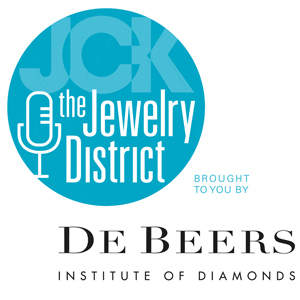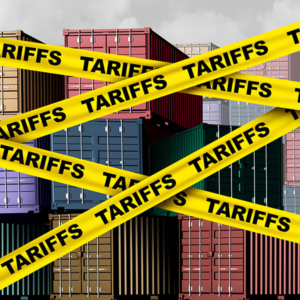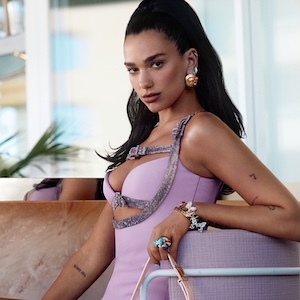
JCK editor-in-chief Victoria Gomelsky and news director Rob Bates open the podcast with highlights from Victoria’s recent trip to Istanbul, where she met with leading jewelry designers and explored the Grand Bazaar. Rob offers insight into WD Lab Grown Diamonds’ decision to file for bankruptcy and what it signals about the changing market. Next, Victoria looks at the evolution of sustainability in luxury watches, from solar power to circularity. Finally, Rob reports on the 1916 Company, a joint venture of Watchbox and three leading independent jewelers.
Listen Now
Sponsored by De Beers: institute.debeers.com
Show Notes
03:49 Turkish delight: Victoria visits Istanbul
09:07 What’s behind WD Lab Grown’s bankruptcy?
14:49 Charting the evolution of sustainability in watches
24:31 Watchbox teams with three jewelers to create new company
Episode Credits
Hosts: Rob Bates and Victoria Gomelsky
Producer and engineer: Natalie Chomet
Editor: Riley McCaskill
Plugs: @jckmagazine; institute.debeers.com
Show Recap
Turkish delight: Victoria visits Istanbul
Victoria shares highlights from her recent trip to Istanbul, where she stayed at the newly opened Peninsula Istanbul, a luxury hotel on the banks of the Bosporus. “From my bedroom window, I could see the minarets of the Blue Mosque, Topkapi Palace, and Hagia Sophia in the distance. It was the most mesmerizing, bewitching view,” she says.
Despite being “a professional tourist” during her stay, Victoria found time to check out the jewelry scene at the Grand Bazaar, where she found “a wonderful vintage watch shop selling groovy, cool gold wristwatches” from the 1970s and 80s, and to visit Aida Bergsen’s workshop and the five-story atelier of Sevan Biçakçi, one of the country’s best-known jewelers.
Istanbul is a must-visit for jewelry lovers, with abundant vintage and antique jewelry as well as a number of innovative makers who are reinventing Turkish craftsmanship for a new generation, Vic says.
What’s behind WD Lab Grown’s bankruptcy?
Victoria asks Rob to weigh in on WD Lab Grown Diamonds’ bankruptcy. The warning signs were there, so the news was no surprise, but it’s still a huge loss, he says. “It’s not a typical Chapter 11, where you try to reorganize,” Rob notes. “It’s just a liquidation.”
WD Lab Grown Diamonds was among the first companies to mass-produce lab-grown diamonds, but its reputation suffered after its purchase by hedge fund Huron Capital, which struggled to manage the business, Rob says. He explains that the falling price of lab-grown gems compounded WD’s problems, as did a bevy of lawsuits WD brought against competitors to protect their patents (not always successfully) and the fact that the company’s products were made in the U.S. while competitors moved to lower-cost production facilities in China and India.
People have long expected some contraction in the lab-grown business after years of rapid expansion and increases in production, Rob says. WD’s bankruptcy is definitely a sign that it’s happening. Victoria wonders what the holidays will bring, and what the implications will be for 2024.
Charting the evolution of sustainability in watches
Victoria discusses a recent New York Times piece she wrote charting the history of sustainability in high-end watches. Superficial efforts traditionally outweighed substantive ones, but that may be changing, she says. A partner at Deloitte Switzerland, which compiles an annual report on the state of the Swiss watch industry, told Victoria its research shows a dramatic shift toward sustainability among brands, with many creating sustainability departments and hiring dedicated officers to oversee their strategy.
The Mondaine Group is often cited as a pioneer in sustainability for creating a solar-powered analog wristwatch in 1973, but the driving factor was convenience—not eco-consciousness, Victoria says. The goal was to build a timepiece that didn’t depend on quartz batteries, which often ran out quickly, she says.
The idea of recycling was anathema to the Swiss even 10 years ago, Victoria says. “You couldn’t have a luxury product that had recycled parts. Luxury was about being shiny and new and prestigious.” The industry has come a long way since then, with models like Panerai’s Submersible ELAB-ID, introduced in 2021 and made of almost 100% recycled material.
Of course, recycling isn’t enough in the eyes of many sustainability advocates; the real litmus test is the sourcing of materials, particularly precious ones. “If you’re not paying attention to where your gold comes from, you’re missing a really big part of the responsible-sourcing conversation,” Victoria says.
Chopard is considered a leader in the movement because the brand introduced the first watch made entirely of Fairmined gold in 2014. Victoria recently interviewed Chopard co-president Karl-Friedrich Scheufele, who explained the genesis of the company’s sustainability focus: In 2008, Chopard produced a wildlife-themed jewelry collection and approached the World Wildlife Fund about collaborating to promote it. WWF was enthusiastic but wanted to know how Chopard was approaching sustainability. Realizing they weren’t addressing the issue at all, the company resolved to start. Since 2018, the brand has used only “ethical gold”—gold that is either Fairmined or accredited by the nonprofit Swiss Better Gold Association, which works to improve conditions for miners and to support responsibly produced gold.
One of the newest sustainable timepieces is ID Genève’s Circular C, made of regenerative materials from wind turbine waste, which can be repaired with heat. “It’s the ethos of the environmental movement in a watch,” Victoria says of the model, introduced this fall.
Perhaps the most exciting aspect of these innovations is their potential to inspire other industries, Victoria says. Makers of anything from boats to skis could incorporate the same sustainable materials into their products to make them more responsibly.
Watchbox teams with three jewelers to create new company
Victoria asks Rob about his Nov. 1 JCK story reporting that pre-owned timepiece e-tailer Watchbox has joined forces with brick-and-mortar jewelers Govberg, Hyde Park, and Radcliffe to create the 1916 Company. What prompted the move? Rob sees it as a response by high-end independents to the growing strength of watch-selling brands like Watches of Switzerland and Rolex-owned Bucherer, some of which are buying independents and opening their own physical stores as part of an expansion strategy.
The 1916 Company, which will offer Rolex certified pre-wwned watches, gives these players a new way to compete. “It’s an interesting model,” he says. “I would not be surprised if other high-end independents go a similar route or join these big brands because it’s getting tougher for smaller independent jewelers.” Consolidating gives them a way to scale up and become more important to key suppliers like Rolex, Rob notes.
Any views expressed in this podcast do not reflect the opinion of JCK, its management, or its advertisers.
- Subscribe to the JCK News Daily
- Subscribe to the JCK Special Report
- Follow JCK on Instagram: @jckmagazine
- Follow JCK on X: @jckmagazine
- Follow JCK on Facebook: @jckmagazine





